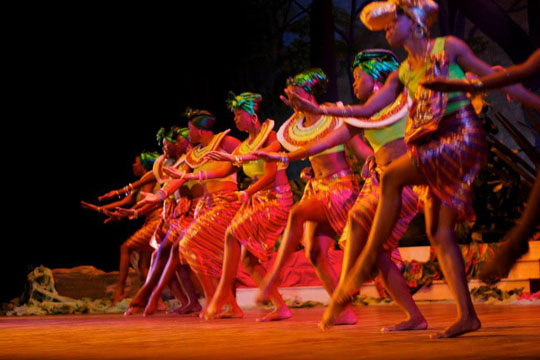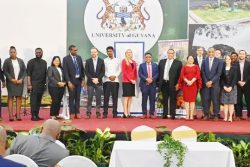The festival of Christmas is an extensive and complex one; the largest and most popular in the world. While it originated as a religious Christian festival, over the centuries it has become many other things, including a traditional, a popular and a commercial festival. It is extremely rich in traditions.
Last week, we surveyed some of those traditions that are theatrical, analysing a few close links between theatre and Christmas. As an opening to this subject, we referenced the stage production “Christmas Funtasia” performed by Guyana’s National Dance Company (NDC). This production showcases many of the Christmas traditions and also draws on traditions within theatre. We used that as an entrée into theatre and Christmas traditions last week.
Today we focus the Dance Company’s “Christmas Funtasia” 2018 itself and examine its dramatisation of Christmas traditions in a bit more detail.
This is the last of five annual, full-dance productions staged by the NDC. It starts the year with a Valentine’s Day programme on the theme of love; then the second is around the time of Caricom Day when the production focuses the Caribbean; this is followed by another production in August, close to Emancipation celebrations and features things African; after that is the biggest of the productions when the annual Dance Season is staged in November. Then comes the Christmas feature.
In December 2018 the “Funtasia” according to its name, is a way of presenting a show that is fun; that entertains and cheers in keeping with the Christmas season, and that is the first custom highlighted in the production directed by leading choreographer and Director of the NDC Vivienne Daniel. And indeed, it was entertaining, producing some humour and other sequences that delighted the audience. This included what looked like a love story that goes through Shakespeare’s theory that “the course of true love never did run smooth” (A Midsummer Night’s Dream). After trials and separation, like the Shakespearean comedies, it reaches its happy ending.
This was one of the ways in which this production was audience oriented, seeming to put some emphasis on having fun with the audience and including elements that would appeal to them. Sure enough, this appeal was achieved in many ways, such as the plot of the dramatisation, already mentioned. But it was also done in a number of theatrical ways.
There was very detailed and thorough attention paid to costuming. This was spectacular, sometimes realistic, but always used to enhance dance, meaning and presentation. Very often it was obviously related to whatever Christmas theme was being treated, at other times to the types of dance. The stage playing area was extended right into the auditorium as dancers very often used the aisles to achieve greater audience impact and intimate theatre. This reaching out was also realised through the role of the MC who was dance teacher and former Company member La Vonne George. She engaged in direct communication with conversation and humour.
Yet there were several other customs and traditions associated with Christmas that the show dramatised, at times reflecting on them. The production delved into many old traditions relating to both Christmas and the theatre, as well as a number of more recent trends. It certainly demonstrated Christmas as a theatrical festival.
Christmas Funtasia dramatised the nativity story. Segments of it were devoted to telling this story in quite realistic fashion, managing to do it through mime and acting, but very rewardingly often through dance, drawing on relevant music and presenting choreographies that narrated or were deeply rooted in the tale of the miraculous birth.
The production was very faithful to the story as related in the Christian scriptures, and dramatised many of the main characters who were protagonists in the drama. These dances included a solo by the Virgin Mary based on the Annunciation as well as the dance of the three wise kings from the east (the Magi). The production managed to achieve these through memorable choreographies.
Many details were staged. There was the scene of the nativity and the participation of the shepherds. The shepherds’ dance was also significant and will be remembered for the spectacular and vivid costuming.
In these ways, the production functioned as a nativity play. The nativity plays were created and performed in mediaeval times by the Catholic Church to teach the people about the Bible and the religion. They told the story of the nativity, and the NDC obviously wanted to perform that function in educating the audience about what Christians believe.
Christmas is remarkable for many of its more popular elements, including the accumulation of its own unique mythology. This was given a place in the production with dances based, for example, on the song “Little Drummer Boy” whose gift to the baby Jesus was to play for him on the drums. Yet the most popular element in the mythology is Santa Claus, who was very prominent on stage. In fact, Santa, who appeared in a number of dances, was one of the popular audience appeals exploited by the production.
This festival originated in the Christian religion and “Funtasia” paid attention to that. There was particular effort to reflect the meaning of Christmas above all the other elements. This was very obvious in the storyline of the main drama around which the whole show was structured. This was the story of love, separation distress, perhaps despair, which was all repaired by reunion in its happy ending.
A number of angels appeared to the protagonist in her moments of depression and pessimism. The angels appeared in the different sequences to emphasise what Christmas is about – proclaiming the spirit of the season and the qualities promoted by the principles of the religion. Here again were the functions of the nativity play.
Additionally, the production borrowed from one of the most outstanding works of literature about Christmas – the novel A Christmas Carol by Charles Dickens. In that novel four ghosts appeared to Ebenezer Scrooge in order to get him to change his anti-social ways in order to save lives and bring Christmas cheer. In “Christmas Funtasia” angels appear to the protagonist to give her hope and lift her out of depression. She is skeptical each time one appears until her situation is eventually resolved and she realises the spirit of the season and the relevance and true meaning of the story. In this way, the messages for mankind intended by the religion are dramatised on stage.
In many other theatrical ways this production explored different aspects of the season through reflection of different traditions past and present. The appearance of classical dancers performing in toe shoes was not coincidental, but very deliberate. It goes back to the ballet and the strong tradition of classical dance related to Christmas and the background of dance in the Caribbean. That element is strong.
On the other hand, the production also paid attention to folk dances. Apart from the classical tradition, folk dances emerged in the Caribbean associated with Christmas or traditionally performed during the season.
Prominent among these is the Parang, practiced in Trinidad and Tobago. This is a musical tradition in which songs are performed in praise of the nativity and glorifying the Virgin Mary, who is virtually worshipped as a goddess. All the songs are sung in Spanish and accompanied by indigenous instruments, including indigenous versions of the guitar along with percussion instruments. The Parang has its own unique rhythm.
Parang was among folk dances represented in the show, reflecting their associations with Christmas. This also enhanced the strength of theatre among the kinds of seasonal traditions in which the NDC production was interested.
It was performed by a large cast. At the core of it were the members of the Company themselves, but they were given much assistance and fortification by a number of associate members in addition to students of the National School of Dance.









